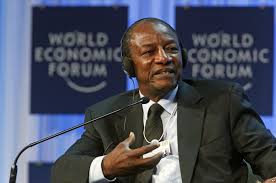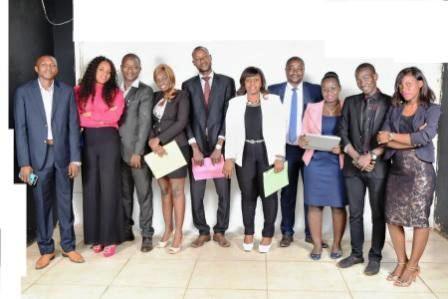 Ahead of the United Nations International Ebola Recovery Conference in New York, President Alpha Condé said: “Together we can stop this disease in its tracks and at the same time give our countries and our people the tools needed to restore our healthcare and economy. If ever there was a time to stick with a vital response, it is now.”
Ahead of the United Nations International Ebola Recovery Conference in New York, President Alpha Condé said: “Together we can stop this disease in its tracks and at the same time give our countries and our people the tools needed to restore our healthcare and economy. If ever there was a time to stick with a vital response, it is now.”
President Condé was in Washington three months ago with the presidents of Sierra Leone and Liberia where they presented a region-wide Ebola Recovery Plan. They also discussed the need to learn lessons from the epidemic and build more robust health systems, while helping affected economies return to the growth levels they enjoyed before the outbreak.
President Condé said: « Ebola hit us hard. We need to transform this grave misfortune to our advantage: if Ebola has spread so quickly and with such magnitude, it is because our health infrastructures are totally failing. We are determined to build a functioning health system, able to confront and prevent future outbreaks, but also to provide universal care to our communities. It is imperative; this requires international financial support. We’re not talking about emergency or ephemeral solutions, but about sustainable and viable responses that go with a health system worthy of that name. We have identified both the problems and the solutions. It’s now time to take action”.
Economically, Guinea particularly focuses on attracting more foreign direct investment in the agriculture, mining and energy sectors, as an engine of development. Despite Ebola, major projects like the Kaleta dam or in the bauxite sector have been maintained and developed. The objective today is to revive and accelerate the dynamics of investments to unlock the potential of the country.
Notes to Editors:
The occurrence of Ebola constitutes an unprecedented shock to the affected countries, striking its most dynamic assets and attacking the social and economic fabric. In Guinea, between March 2014, the official reporting date of the epidemic, and 15 June 2015, there were 3,245 confirmed cases of contamination and 2,026 cases of death, and more than 600 widows and widowers and nearly 6,000 orphans. The prevalence of the disease revealed that there were more victims among women, around 53 percent of the total, and that nearly 20 percent of infections involved children.
The health impact is compounded by the fear around Ebola, which has led people to reject proper health practices: a 20 percent decline in use of health facilities for assisted births; a 25 percent decline in prenatal consultations by 25 percent; and, the closing of 94 health centres and district hospitals in December 2014. Vaccination coverage has also decreased by 30 percent. To secure children’s lives and those of the general population, the Government had to delay the opening of 2014-2015 school year by four months. The country experienced a drop in school attendance (around 35 percent), especially in areas severely affected by the disease.
The disease also had a violent impact in economic and financial terms. The real economic growth rate declined significantly to 1.1 percent in 2014, against a forecast of 4.5 percent, while for 2015, the projected growth is zero. The tax revenue shortfalls caused by these reductions are estimated at over 1,150 billion Guinean Franc (approximately US$160 million) while expenses are increasing due to the demands for health care needs in the prevention and treatment of the disease.
Based on the issues and challenges posed by Ebola, the Government has developed its strategy to allow Guinea to recover from the consequences of the crisis, upgrade and develop its health system to meet both immediate needs and long-term challenges, provide universal access to water, sanitation and hygiene for all, rebuild its economic and social development, and resilience. This strategy has resulted in a Post-Ebola Priority Action Plan (PAPP) built around programmes and investment projects, and relevant support measures for recovery and resilience. The total estimated cost of the PAPP over the 2015-2017 period will amount to US$2.577 billion. Based on the project financing in place and the Government’s contribution, the remaining funding needed under the PAPP financing plan totals USD 1.534 billion for 2015-2017.
The Press office of the Presidency of the Republic of Guinea.













